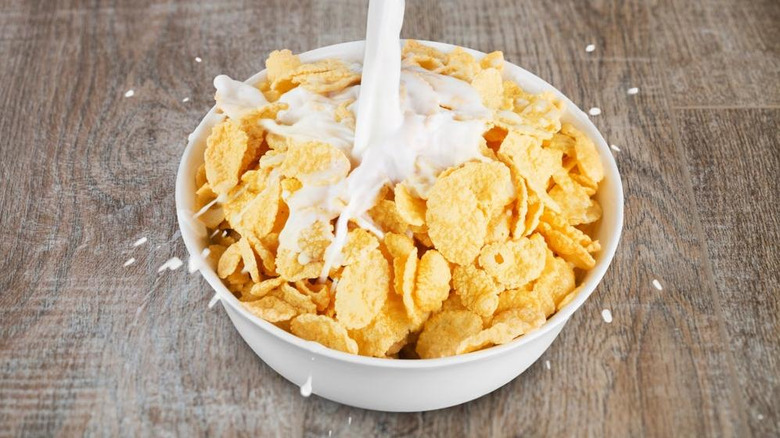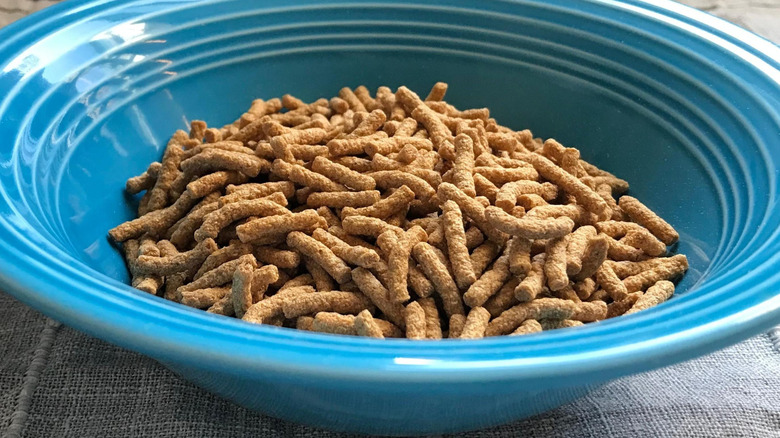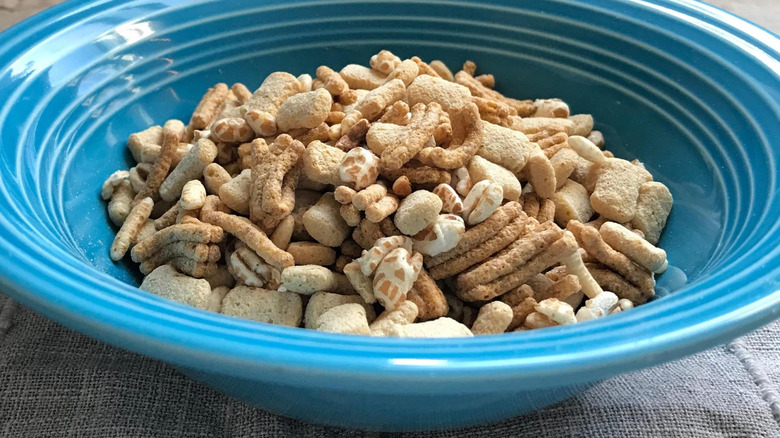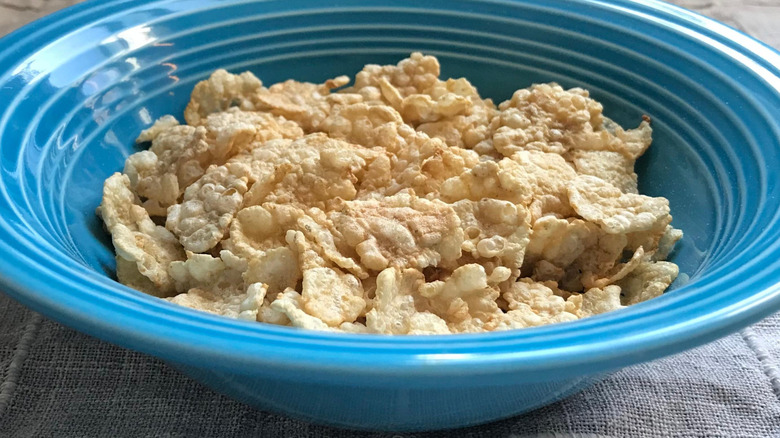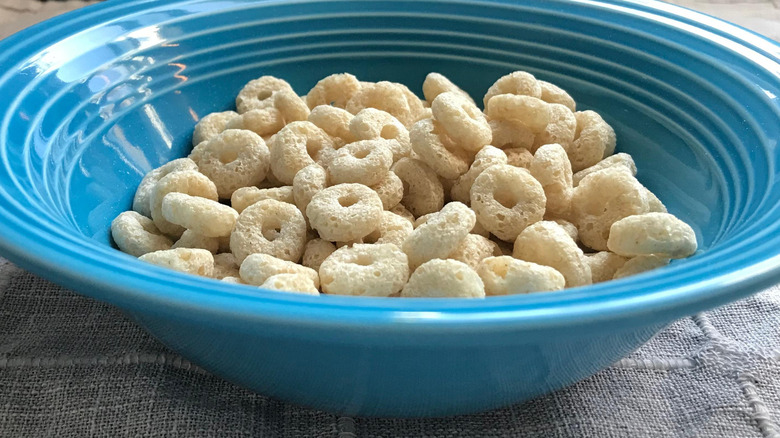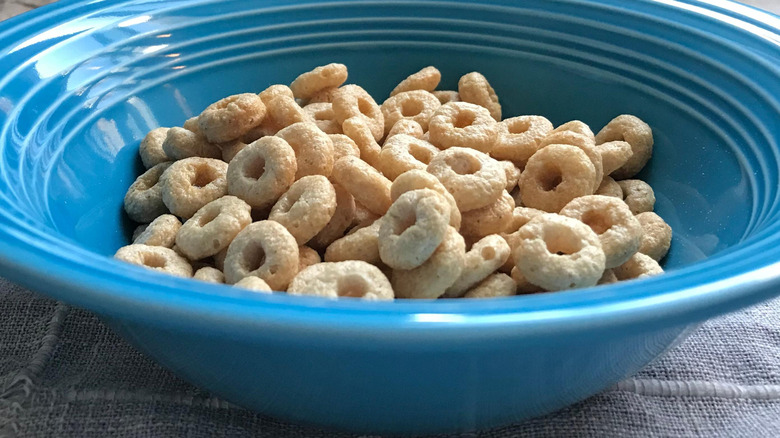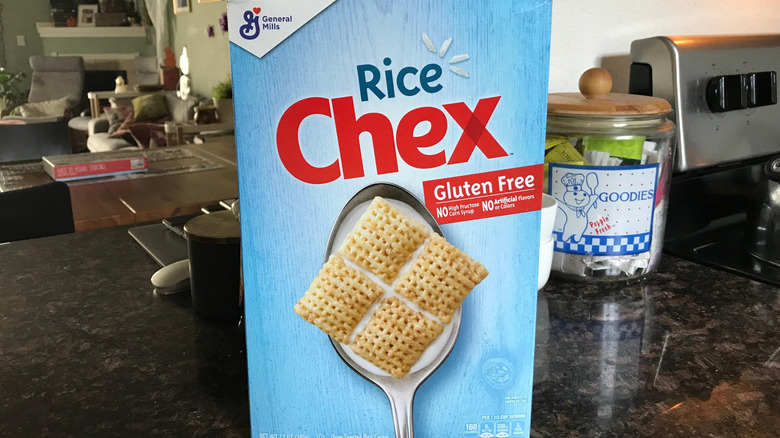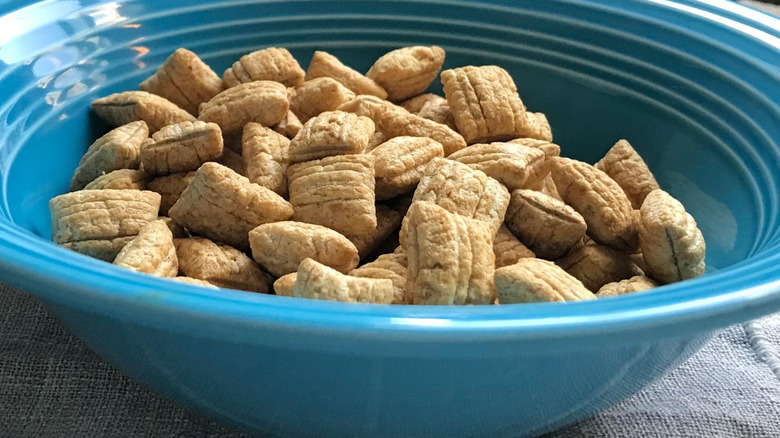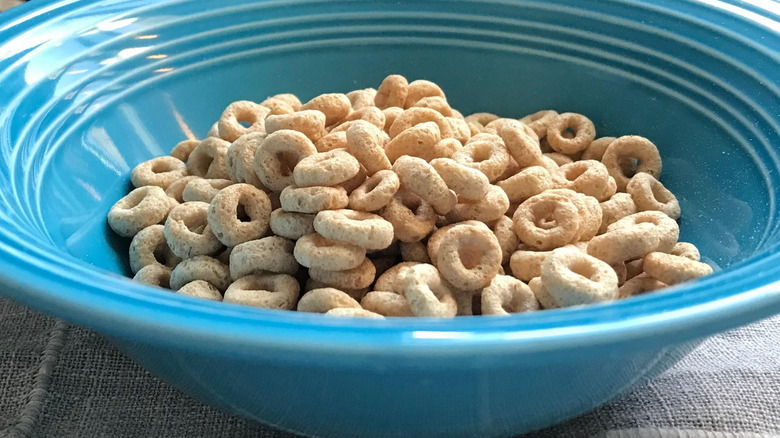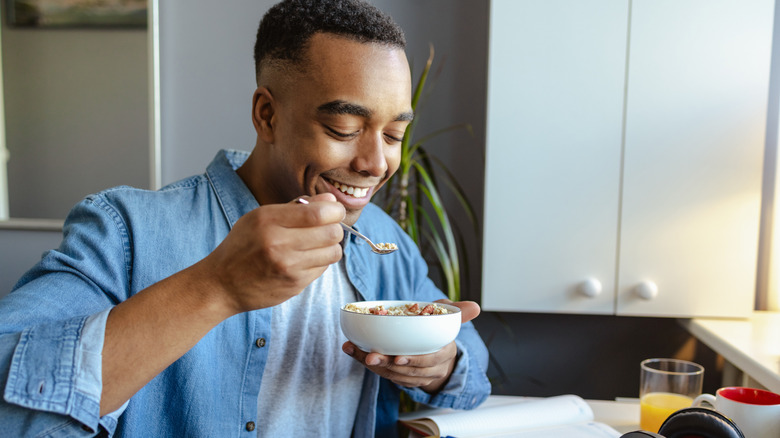8 'Healthy' Cereals, Ranked Worst To Best
If you're a parent in the 21st century, you are well aware of the multiple holidays on which sugar consumption is at its peak — and Halloween is among the worst culprits. Speaking from experience, I can tell you that spending hundreds out of pocket for your children's fillings is slightly less fun than trick-or-treating. A nice way to offset the sugar rush is to feed your young ones better, healthier cereals at the start of each day. But what exactly are "healthy" cereals, anyway?
You'll find many different answers to this question online, including recommendations of brands allegedly preferred by nutritionists. The Cleveland Clinic, on the other hand, recommends looking at whole grains, fiber, protein, and of course, low amounts of sugar and sodium. Below is a selection of eight cereals that best fit these criteria, ranked from worst to best.
8. Fiber One Original Bran Breakfast Cereal
Fiber One is, true to its name, high in fiber. It's made with whole grains, and according to its website, eating this cereal promotes digestive health. This sounds great in theory, but what matters is whether my household will want to eat it — and when it comes to the actual taste, it was a mediocre cereal that was more hype than quality.
Rather than the typical O's or flakes of other breakfast cereals, these tubular bites reminded me of really thick, uncooked chow mein noodles. These "noodle bits" were short, stubby, and mostly broken in the bag. The flavor was nothing memorable, and had some cardboard notes. If you opt for Fiber One, I recommend the Honey Clusters variety instead.
7. Kashi GO Original Cereal
"There's a lot going on in this box, including weird little stick bundles, pellets of crispy puffed rice, and even whole oats for chew," wrote Gwynedd Stuart for Sporked on the topic of this cereal. "It's a true festival of tastes and textures." While I do agree that there's a lot going on, I do not agree that this is a positive thing. In fact, I found the variety of shapes, sizes, and crunch levels in a box of Kashi GO Original to be quite off-putting.
Some were big, hard bits; others were tiny, yielding clusters. It tasted overall lightly sweet, which was nice. I liked the fact that it was low in fat and high in fiber; however, my taste testers weren't super impressed with the taste, deeming it "just okay." Kashi GO doesn't sit too high in their rankings.
6. Kellogg's Special K Original Cereal
Kellogg's cereals have been around for a very long time, and their success is interesting considering the history of eugenics-aligned practices attributed to John Harvey Kellogg and his association with the Race Betterment Foundation. I guess a century of distance makes it easy to forget where America's breakfast comes from.
Special K Cereal is, at its core, a low-calorie cereal with very little fat, salt, and sugar. That's its primary goal, and it has a flavor to match. My partner likened the taste of Special K to the box it comes in: very paper-like and extremely dry. It's a good choice for someone who doesn't want their breakfast overwhelmed by a whole lot of flavor or moisture. I will give Special K credit for being a kosher-certified product, high in protein and vitamins and minerals. But if you're looking for a "healthy" product, it can still be a little more fun than this.
5. Love Grown Power O's (Original)
Love Grown Power O's cereal is huge. Physically huge. Think of a Cheerio inflated three times over. Each "O" is a piece of toasted, unsweetened rice and bean cereal, and its flavor indicates this; if you're a fan of Rice Krispies, this is the one for you. Its bean blend (navy, lentils, and garbanzo) is mixed with rice flour, salt, and vitamin E, and in a 1¼ cup serving, you'll get 130 calories and very little fat and sugar. It's perfectly plain and round, thank you very much.
However, I have to stop here because at almost $7 per box, it's on the pricey side for not a lot of cereal. I also think that because the cereal pieces are so large, it would be better as a crunchy snack rather than a breakfast item.
4. Cascadian Farm Honey Nut O's
Cascadian Farm cereal boxes are beautiful, a highlight of the whole cereal aisle. This product is very sweet and very crunchy, which I loved. My kids loved it too. But the more I thought about it, the more I could hear a voice inside saying, "Maybe that sweetness isn't that healthy after all."
I am supposed to be judging things based on what's "healthy," right? And I've decided that sugar is a huge determining factor in what's healthy, followed by calories and fat and sodium. This cereal hits the mark on whole grains (27 grams!) and dietary fiber (3 grams) per serving, but teeters over the 10 gram sugar limit I set in my criteria, at 11 grams total per bowl. Indeed, it's worth noting that this is essentially a Honey Nut Cheerios knockoff with only slightly less sugar.
3. Rice Chex
Admittedly, I've always loved Chex cereal. My kids in particular are fans of Cinnamon Chex; however, because we're talking about healthy cereals here, I put Cinnamon Chex out of the running. (We still love it, but in moderation.) Enter Rice Chex, its plain-Jane cousin. These pieces have a nice, flaky crunch that's light and airy and immensely satisfying. I cannot explain why it's so appealing; I can only observe what my kids ate, which was a lot of it. After the first bowl, they asked for more.
Rice Chex isn't trying to do too much — it's a basic, gluten-free cereal made with simple ingredients (whole grain rice, rice, sugar, salt, molasses, and vitamin E). The result is a fluffy, crunchy, and perfectly plain unsweetened cereal that's great with milk or eaten straight up as a snack. While other cereals aim for this balance, the Chex shape is key to its appeal.
2. Puffins Original Cereal
Puffins, which can be found at Trader Joe's, Whole Foods, and other big grocery chains, have always been a hit in our household. Perhaps it's due to the penguin on the front calling out to the kids, or perhaps because it's a perfectly sized bite of cereal that reminds me of Cinnamon Toast Crunch with better structure.
Puffins are vegan, kosher, made with whole grains, high in fiber, and contain 6 grams of sugar and 130 calories per serving, placing them squarely within all my metrics for a "healthy" breakfast. We all rated this one high on its oat-like crunch, which remains crunchy even if it stays in the box for several months (or in a bowl of milk for several minutes).
1. Cheerios
When it comes to healthy cereals, nothing beats Cheerios. The bright yellow box is enticing and familiar, but when you really bite into it, everything about this cereal simultaneously screams healthy and tasty. That's exactly what makes Cheerios special: Seemingly everyone, everywhere, agrees that Cheerios are unmatched in size, crunch, flavor, texture, and consistency. What other product on earth has built this kind of consensus?
A box of Cheerios is also one of the more affordable options at the store, and can be found just about everywhere. Out of 669 reviews on its product page, 572 people gave it a 5-star rating. When it comes down to it, comfort, familiarity, and consistency are what win the hearts and minds of Americans at breakfast time.
Methodology
To pinpoint the best cereals, I took the Cleveland Clinic's advice and melded it with my own knowledge of what my family will eat. The criteria were simple:
- 200 calories or less per serving
- 10(ish) grams of sugar or less per serving
- Some kind of whole grain promise
- Low sodium content
(I figured my kids can get their protein and fiber from other sources like eggs, sausages, and Greek yogurt.)
Even with these criteria narrowing the field, I was overwhelmed by the amount of cereals available at the grocery stores in my area. One store alone had two separate aisles dedicated to cereal: one with "regular" brands such as General Mills, Post, and Kellogg's, the other full of "natural" or smaller organic brands.
